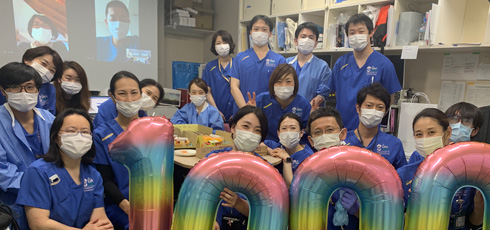
Overview
To ensure a safe and comfortable surgery
Anesthesiology
Many may consider the job of anesthesiologists to be only giving anesthesia to patients undergoing surgery. However, their job is much more complex. Their role extends beyond the operating room.
Before the operation, anesthesiologists see their patients for outpatient consultation to explain the anesthesia that will be used and to evaluate the patient’s physical condition.
On the day of the operation, they ask the patient if they slept well, are feeling anxious or if there are any changes in their physical condition before entering the operating room with them.
Once inside the operating room, they will apply the type of anesthesia most appropriate for the patient, including general, epidural, spinal, or other types of anesthesia. They act as the patient’s life support by sustaining blood pressure and heart rate during surgery, standing closer to the patient than the surgeons, and monitoring and reporting the patient’s condition to ensure that the operation runs smoothly. This detailed care can minimize stress by controlling pain and anxiety. Anesthesiologists are especially careful with regard to anxiety in children. Children from the age of one up until elementary school have the option of having a parent enter the operation room until the anesthesia kicks in (pediatric surgery, plastic & reconstructive surgery).
After surgery, anesthesiologists observe patients in the recovery room until they wake up, confirm if there is any pain and check their condition before returning them to their room.
The next day, a doctor from the Department of Anesthesia will visit the patient in their room asking about pain or other concerns, checking if the anesthesia and physical management was adequate during the operation.
It is the job of the Department of Anesthesia to comfort the patient and make sure the operation proceeds without any complications. The anesthesiologist’s job is total coordination of physical and emotional management, and pain control.
Intensive Care
When the overall condition of the patient becomes severe enough that detailed supervision and treatment is necessary, the patient will be admitted into the intensive care unit where doctors and nurses will manage the patient’s condition around the clock. An anesthesiologist will work together with doctors from other departments to provide the most effective treatment.
Perioperative Care
Operative care is not limited to the operation room but also includes the pre-operative and post-operative process. Doctors from various disciplines including anesthesiologists, surgical nurses, clinical engineers and pharmacists work together as a team.By sharing information with each section, we are able provide the best possible care to each patient throughout the operative cycle; pre-operative, operative and post-operative. This is what we call “perioperative care.” Our goal is to treat all our patients with this teamwork approach in order to provide optimal care.
Perianesthesia Nurses
Perianesthesia nurses are hospital-certified nurses who have graduated from the St. Luke’s College of Nursing Graduate School with education/training in the Nurse Anesthetist Master’s Course (2 years). They acquire the techniques necessary for administrative support of anesthesia, such as airway and cardiorespiratory management.
Working under the instruction and supervision of an anesthesiology specialist certified by the Japanese Society of Anesthesiologists, they help support anesthesiology operations both inside and outside of the operating room. This includes patient evaluation and explanation before and after anesthesia, whole-body management during anesthesia, post-operative pain control and sedative/pain-relief management. Our nurses help provide a safe and reliable anesthesia procedure that considers the patient’s feelings by understanding anesthesia, assisting the doctor as a nurse and providing support for the patient. Perianesthesia nurses only work under the direct supervision and instruction of anesthesia specialists in accordance with Japanese law.
